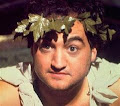UK/C-109m./Dir: Edgar Wright/Wr: Simon Pegg & Edgar Wright/Cast: Simon Pegg (Gary King), Nick Frost (Andy Knightley), Paddy Considine (Steven Prince), Eddie Marsan (Peter Page), Martin Freeman (Oliver Chamberlain), Rosamund Pike (Sam Chamberlain), Pierce Brosnan (Guy Shepherd), David Bradley (Basil), Michael Smiley (Reverend Green)


There are no better comedy writers working today than Simon Pegg and Edgar Wright. While most movie comedies are disposable fluff that barely merit a single viewing, the Pegg/Wright collaborations --
Shaun of the Dead (2004),
Hot Fuzz (2007),
and
The World's End (2013)
-- are infinitely re-watchable, like the best films of Preston Sturges or Billy Wilder. The screenplays are so brilliantly layered and meticulously thought out (stuffed with foreshadowing and comic callbacks) that they reward multiple viewings.

After the brilliant one-two punch of
Shaun of the Dead and
Hot Fuzz, it was hard to imagine that the pair could concoct another comic brew that would be anywhere near as intoxicating as what came before it. However,
The World’s End, the final film in the loosely connected
“Three Flavors Cornetto” trilogy,
is the best and booziest of the bunch. It is arguably the funniest and most quotable of the three films. Best of all, it is the most emotionally resonant and mature.

Simon Pegg plays against type as alky ne’er-do-well, Gary King, who persuades his more responsible childhood friends -- Andy Knightley (Nick Frost), Steven Prince (Paddy Considine), Peter Page (Eddie Marsan), and Oliver Chamberlain (Martin Freeman) -- into joining him in recreating an epic pub crawl that they attempted but never completed twenty years earlier. The so-called “Golden Mile” requires the downing of a pint in twelve taverns, ending at the fatefully-named pub, “The World End.” Along the way, the “five musketeers” face old loves, inner demons, and exterior threats that require every ounce of their liquid courage.

For a silly action/comedy,
The World’s End has a lot on its mind. Fundamentally, it is about the point in life when living in the past becomes pathetic. However, it also juggles the themes of mid-life crisis, corporate homogenization of local culture, the nature of friendship, the choice between ignoring or facing your personal demons, and the idea that “you can’t go home again.” Yet, despite the abundant dark subtext, Pegg and Wright manage to meld the disparate elements into a fresh and funny brew.

Not only is the script exceptional, the cast is first rate. Supporting actors Paddy Considine, Eddie Marsan, Martin Freeman, Rosamund Pike, and David Bradley all make the most of their moments to shine. As for the leads, Simon Pegg and Nick Frost turn in “career-best” performances. In the hands of a lesser actor, the role of Gary King could have been insufferable to the point of repugnance; but Pegg’s comic timing, natural likeability, and ability to show the trampled heart beneath his bluster keep the audience rooting for the delusional drunkard. Nick Frost is just as good in the more buttoned-down role of the reluctant companion, seething below the surface. Frost’s restraint during the first half of the film makes his Sammo Hung-like "hulk-out" in the film’s action climax all the more ferocious.

Unlike many writer/directors, Edgar Wright is an adept visual stylist as well as a wordsmith. Whether a scene calls for a simple dialogue between two actors or an action free-for-all à la Jackie Chan, Wright finds imaginative ways to view the setup. The way scenes are composed and edited gives added punch to the punchlines, and even the most frenetic action scenes are always fully comprehensible.

The World’s End is the ultimate bar crawl movie and an instant classic. I hope this isn’t the final partnership between Wright, Pegg, and Frost; but they couldn’t have ended their “Three Flavors Cornetto” trilogy on a more intoxicating note. Like their previous cocktails, I anticipate revisiting this brew again and again.

 Drinks Consumed
Drinks Consumed--Beer (Crowning Glory, Foster’s, and unnamed), wine (red and white), and unspecified shots
Intoxicating Effects--Swearing, slurred speech, staggering, stumbling, belching, vomiting, loosened inhibitions, soused sex, sneaking sips, the giggles, bickering, brawling, physical violence, destruction of property, bar tossed, and drunk driving
 Potent Quotables
Potent Quotables--B&B LANDLADY: Have you got any plans for dinner at all?
GARY: Tonight, we will be partaking of a liquid repast as we wend our way up The Golden Mile. Commencing with an inaugural tankard at The First Post, then onto The Old Familiar, The Famous Cock, The Cross Hands, The Good Companions, The Trusty Servant, The Two Headed Dog, The Mermaid, The Beehive, The King’s Head, and The Hole in the Wall for a measure of the same. All before the last bittersweet pint in that most fateful terminus, The World’s End. Leave a light on good lady, for though we may return with a twinkle in our eyes, we will, in truth, be blind… drunk.
 Video Availability
Video Availability--
DVD
and
Blu-ray
(Universal)
Similarly Sauced Cinema--Taverns and pubs also played major parts in the first two installments of the Cornetto Trilogy,
Shaun of the Dead (2004) and
Hot Fuzz (2007). The World's End / Hot Fuzz / Shaun of the Dead Trilogy (Blu-ray + Digital HD with UltraViolet)
The World's End / Hot Fuzz / Shaun of the Dead Trilogy (Blu-ray + Digital HD with UltraViolet) Read more...
Read more...











































.jpg)














